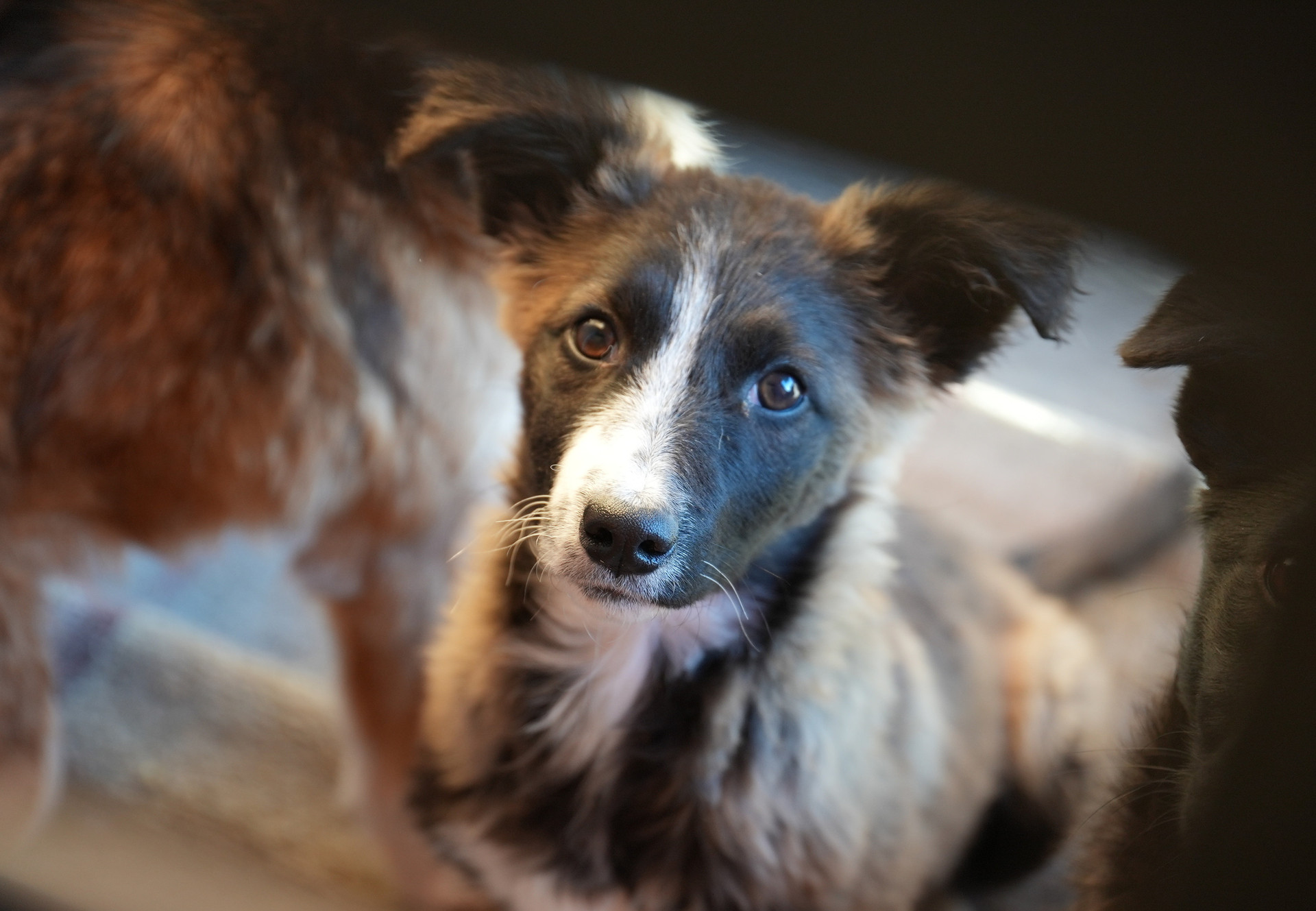
Stray Animal Care
Everything you need to know about homeless pets and our work for them
What is a stray animal?
Stray animals, specifically dogs and cats, are those animals who are either born on the streets or have become homeless due to abandonment. Lost animals are also sometimes referred to as stray animals who are usually returned to their owners if they are microchipped or have a collar with an identity tag when found.
Read more about stray animals and the dynamics in their population.
Why is FOUR PAWS taking care of stray animals?
The human-dog and human-cat relationship are not new: the bond between dogs, cats and humans has been forged for centuries and ever since, these animals have always played an important role in the history of humans. Today, most dogs and cats are companion animals (as pets or community animals), dependent on humans for their care. This means that we, as humans, have a duty of care towards them, and we are betraying dogs and cats when we treat them cruelly or abandon them to become a stray. And for stray dogs and cats, each day on the streets is a struggle to survive. They do not have access to basic necessities such as food, shelter or medical care. Additionally, they form a risk to public health as they can carry various zoonotic diseases, be aggressive or cause incidents and accidents. It is therefore not just our duty but also vital, both for animal welfare and public health, to take care of stray animals and reduce their numbers.
Where is FOUR PAWS taking care of stray animals?
We implement sustainable and humane dog/cat population management programs in various countries in Eastern Europe (Romania, Bulgaria, Ukraine, Moldova), Southeast Asia (Thailand, Vietnam, Cambodia, Indonesia) and India. Additionally, we have carried out several missions to help stray animals in other countries around the world.
Can FOUR PAWS help stray animals in my country?
For the moment, our primary focus is on helping municipalities and communities in Eastern Europe and Southeast Asia, where we have signed Memorandums of Understanding with local authorities or partnership agreements with local animal welfare organizations. While we are open to exploring individual cases and offering assistance whenever possible, it is important to understand that our resources are limited, and therefore we are unable to extend help everywhere. However, we have in place a number of training tools to help local animal welfare organizations and communities with their stray animals such as our Shelter Adoption Academy which has been designed to help shelters worldwide increase their local adoption rate.
What does FOUR PAWS’ work for stray animals involve?
We address various angles of the stray animal problem. First and foremost, FOUR PAWS works together with the local community, such as the authorities, law enforcement, local veterinarians, local animal welfare organizations and other members of the community. Therefore, ‘Community Engagement’ is essential in our projects. We address topics such as community attitudes and behaviors towards strays via our Animal Assisted Interventions approach and Responsible Pet Ownership, as irresponsible ownership is one of the root causes of the stray animal problem. To reduce the number of stray animals in a humane and sustainable way, we use the Catch-Neuter-Vaccinate-Return approach. Additionally, we medically treat injured and sick stray animals. To have a better understanding of the size of the stray animal population in an area, the dynamics within the population and the possible relationships of stray animals with the community they live in, we use ‘Monitoring, Evaluation & Impact’ tools as an essential approach throughout our entire project. Last but not least, as we believe each dog and cat deserves a loving home, we try to create local adoption culture and improve local shelters via our Shelter Adoption Program.
Why do you return stray dogs and cats back onto the streets after they have been sterilized and vaccinated?
While we would like to see every dog and cat living in a caring home with responsible owners, there is sadly a large and unwanted population of stray dogs and cats, and there are simply not enough homes for all these animals. Therefore, animals that are fit and strong enough for life on the streets will be returned to their original territory to live out their days with their canine/feline friends and, wherever possible, with local caregivers that provide regular food, water and shelter.
Once these animals are sterilized, their chances of survival and living a long, healthy life are much improved. Animals that need specialized care, for instance, because they are too young to be returned to the streets or have a disability which makes it even harder for them to survive, we try to find a local home for them.
Along with sterilization programs, FOUR PAWS also implements programs which aim to reduce the abandonment of more dogs and cats onto the streets (Responsible Pet Ownership) and encourage adoptions from shelters.
How do you ensure sterilized stray dogs/cats are safe?
All stray dogs and cats that are sterilized and vaccinated, receive a mark: dogs get an ear tag, while the top of the ear of cats are tipped. They are also microchipped. This is a sign to the community that these animals have been sterilized and vaccinated and will no longer contribute to the growing population, nor will they be a health risk to the community. Of course, this goes simultaneously with our Community Engagement approach, in which we involve the community in our work for strays.
Furthermore, it is important to note that FOUR PAWS only works in municipalities where there is a no-kill policy.
Can I adopt a stray dog or cat?
How fantastic that you would like to adopt a pet, because we totally support the phrase ‘Don’t shop, adopt!’. If you would like to adopt a dog or cat, we highly recommend that you visit your local animal shelter to discuss this further with them. There are thousands of animals including puppies and kittens in shelters needing responsible homes, sadly many are only there because they have been purchased on impulse and are no longer wanted. By deciding to adopt, you are not only helping an animal in need, you will find this a very rewarding experience.
Can I support your stray animal care projects as a volunteer?
Thank you so much for your interest to become a volunteer. To support our stray animal care work we need highly-skilled professionals that are trained to perform high-volume treatments with a focus on high-quality clinical practice, as well as professionals that are trained to catch, handle and transport stray dogs and cats in a humane way. If you have these skills then please keep an eye on our website, for volunteer opportunities. If you are looking into other ways of supporting FOUR PAWS through volunteering, you can find further information here.
How does the Community Engagement Program work?
The Community Engagement Program operates through a multifaceted approach to address the issue of stray animals. It begins by establishing close partnerships with municipalities and collaborations with local communities and relevant stakeholders. The program conducts extensive research and assessments to understand the specific challenges and needs of each community.
Based on the findings, a community action plan with tailored initiatives is developed and implemented by the community, with the support of FOUR PAWS. This plan often includes awareness campaigns, educational workshops, and public events, which focus on promoting responsible pet ownership, spaying and neutering, and the importance of adopting animals from shelters. These activities aim to change societal attitudes towards stray animals and instill a sense of compassion and empathy within the community. Read more about our Community Engagement approach.
How can community members get involved in Community Engagement?
Community members can actively participate in their local communities and make a positive impact on animals in several ways:
- Through volunteering their time and skills to support local dog and cat shelters or municipal initiatives such as assisting with adoption events, participating in spaying/neutering projects, or helping with awareness and educational initiatives.
- Community members can consider adopting a dog or cat from local shelters. By providing a loving home to a shelter animal, they contribute to reducing the local shelter population and improving the well-being of individual animals.
- Community members can become ambassadors for responsible pet ownership in their local community. They can ensure pets are properly cared for, microchipped, vaccinated, and spayed/neutered. By setting an example, they inspire others in the community to follow suit and take responsibility for their pets.
- If community members encounter issues related to stray animals, such as overpopulation, abandonment, or mistreatment, they should report their concerns to the local authorities to take appropriate actions to address the situation.
- Community members can actively participate in community events to help raise awareness, gather support, and contribute to addressing the plight of stray animals in their local area.
By engaging in these various ways, community members become an essential part of the humane stray animal population management by creating a more compassionate and responsible community.
What are the benefits of the FOUR PAWS Animal Assisted Interventions program?
Animal Assisted Interventions have numerous benefits for participants. Interactions with animals have been shown to reduce stress, anxiety, and feelings of loneliness while promoting relaxation and positive emotions. Most importantly for our work, however, AAI can improve social skills, promote empathy, and encourage positive attitudinal and behavioral changes. The healing power of the human-animal bond fosters positive attitudes towards stray animals and improves their welfare, while simultaneously enhancing the well-being of people involved. Read more about our AAI program.

